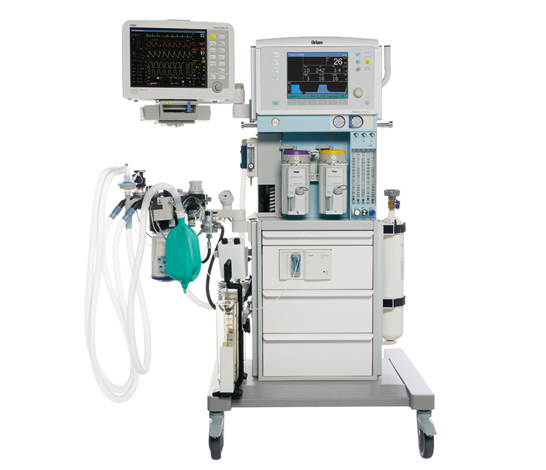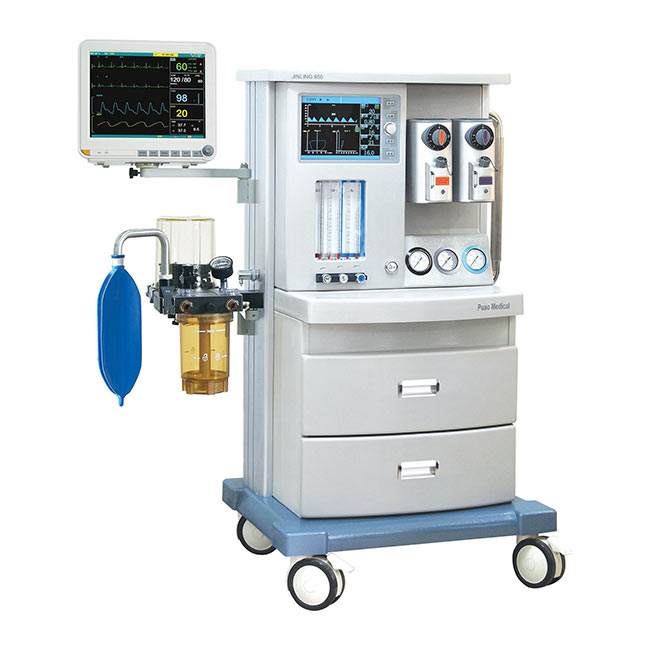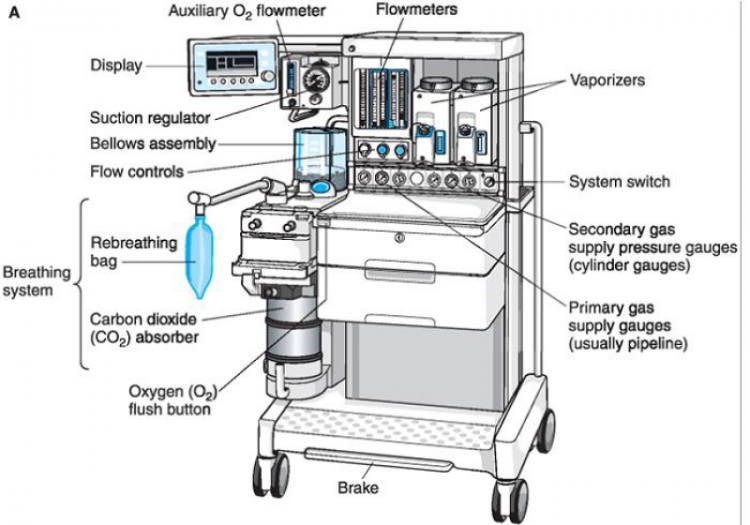
An anesthesia machine or anesthesia machine or Boyle machine is used by an anesthesiologist or nurse anesthetist to maintain anesthesia during surgery. The most common type of anesthesia machine currently in use around the world is the continuous flow anesthesia machine, which is designed to deliver a constant and precise amount of a medical gas mixture (such as oxygen or dinitrogen monoxide) at a constant rate. combine anesthetic gases (such as isoflurane) and finally deliver the patient safely with a constant flow and pressure.
The main idea of the current anesthesia machine was proposed and invented by a British anesthesiologist named Henry Edmund Gaskin Boyle in 1917. Before that, anesthesiologists used to carry all the necessary equipment and tools with them, but the development of these tools made these tools heavier and difficult to transport. The large gas capsule as well as the increasingly complex airway equipment and the existence of these problems indicated that this situation could not be continued in all situations if the anesthesia machine was installed on anti-static four-wheels suitable for transportation.
In certain situations, a simpler anesthesia machine may be used. For example, the TriService anesthesia machine is a simple anesthesia delivery system invented for use in the British Armed Forces. This device is light and portable and can be used effectively even when medical gases are not available. This device has a one-way valve that draws in ambient air and enriches it with oxygen that enters the device from the capsule.
Still in India, a large number of draw-over type anesthesia devices are used, by which the mixture of air and ether is enriched with oxygen and delivered to the patient, but with the advent of the cautery device, the possibility of explosion of this gas mixture is high, which has led to the use of this The device is associated with risks.
In dentistry, a simplified example of anesthesia machine is used, where there is no ventilator and vaporizer, and it is originally called as relative anesthesia machine. By using this machine, the dentist can use a mixture of oxygen gas and dinitrogen monoxide for the patient so that the patient is calm and pain-free during the work.

The modern anesthesia machine includes the following components: [1] [2] [3]
Connecting to the hospital’s central source of oxygen, as well as connecting to the source of dinitrogen monoxide and the central air source
Connecting to air, oxygen and dinitrogen monoxide storage capsules, each of which is connected to the device with dedicated connections.
Flush button that provides oxygen with a flow of 30 to 75 liters per minute.
Pressure gauge, regulator and a pop-off valve that protects the device components and the patient from high pressure oxygen entering and being damaged.
Oxygen, air and dinitrogen monoxide flow meter
A precision vaporizer that provides a precise dose of inhaled anesthetics.
A ventilator that ventilates the patient during anesthesia.
A manual ambo bag that is combined with a pressure regulating valve and is used when needed.
Monitoring and control system of patient inspiratory and expiratory gases
There should be a system for patient monitoring, including heart rate monitoring, EKG observation, and determination of blood pressure and oxygen saturation in arterial blood. In some other anesthesia devices, more things are included, such as capnography and thermometer.

Based on the experiences gained from past mistakes, modern anesthesia machines are equipped with several features to increase security, which include: [2][1]
Oxygen Pressure Drop Warning (OFWD for short): Older machines had a pneumatic device called a Ritchie whistle that started to whistle when the oxygen pressure dropped below 36 psi, but in newer machines instead of That part or electronic sensor is placed.
Dinitrogen monoxide gas flow interrupter (abbreviated OFPD): The flow of medical gas dinitrogen monoxide is completely dependent on the oxygen pressure. This mechanism is carried out at the level of the oxygen regulator. Its basis is that the dinitrogen monoxide flow regulator is completely dependent on the oxygen flow regulator. For example, when the flow of oxygen is interrupted, the flow of no other gas will be established.
Hypoxic gas mixture warning: This mechanism will prevent the delivery of a gas mixture that contains less than 21-25% oxygen. In modern devices, it is impossible to give a gas mixture without oxygen to the patient. In these devices, oxygen will automatically be added to the fresh gas stream even if the anesthesiologist decides to give the patient 100% nitrous oxide.
Mechanical ventilator warning: The device warns when the airway pressure is higher or lower than the standard.
The presence of a lock between two vaporizers: this mechanism is placed in the anesthesia machine to prevent the simultaneous administration of two inhaled anesthetics.
Placing special pins on the connecting part of gas capsules and the device: this makes it impossible to connect the wrong capsules to the device.
NIST or Diameter Based Safety System (DISS): Using this system, the diameter of the pipes entering the device is different based on what type of gas they contain.
The connecting valve to the anesthesia machine hoses are non-replaceable and exclusive. As a result, the possibility of changing a hose valve by mistake will be eliminated.
All the functions of the anesthesia machine should be checked by the user of the device every time, also the anesthesia machine and all its accessories should be periodically checked and calibrated. Older cars may not have some of the features and improvements that newer cars have. However, the old devices were designed to work without electricity and using air pressure, while the new devices work with electricity and have a backup battery, but if this battery is empty, the device will stop working. .
However, modern anesthesia machines still retain the old principles of Boyle’s machines.
It is recommended that two people check the device before each use of the anesthesia machine, this will greatly reduce the risks and complications.
Source: Wikipedia
